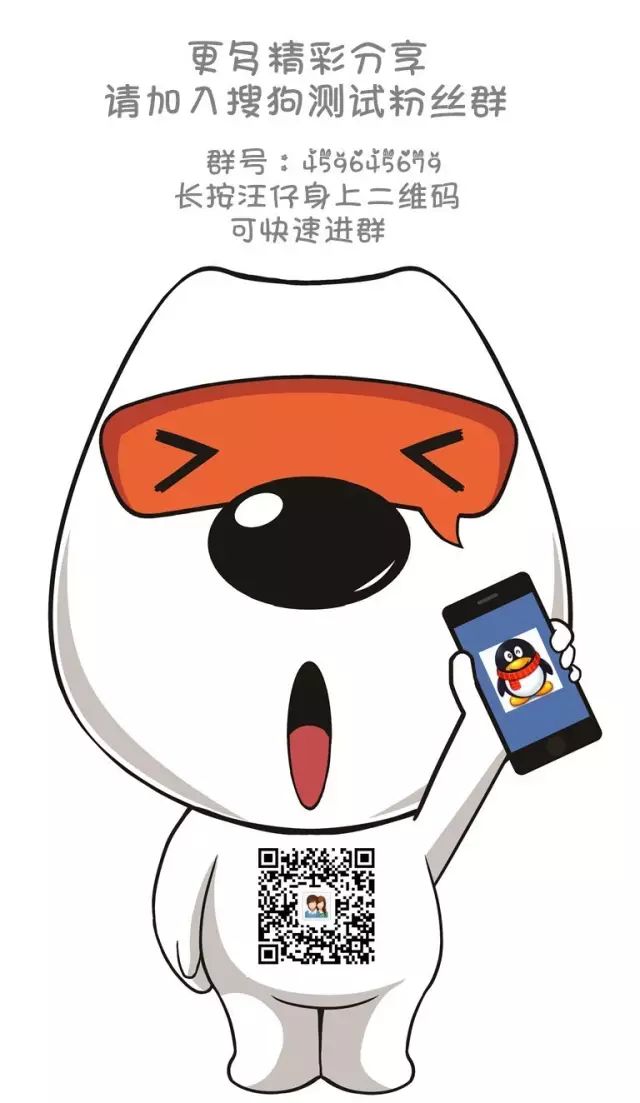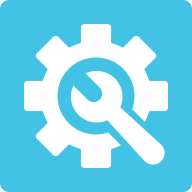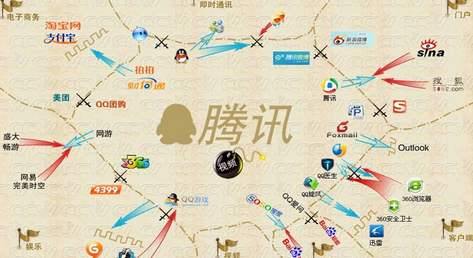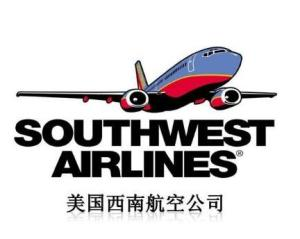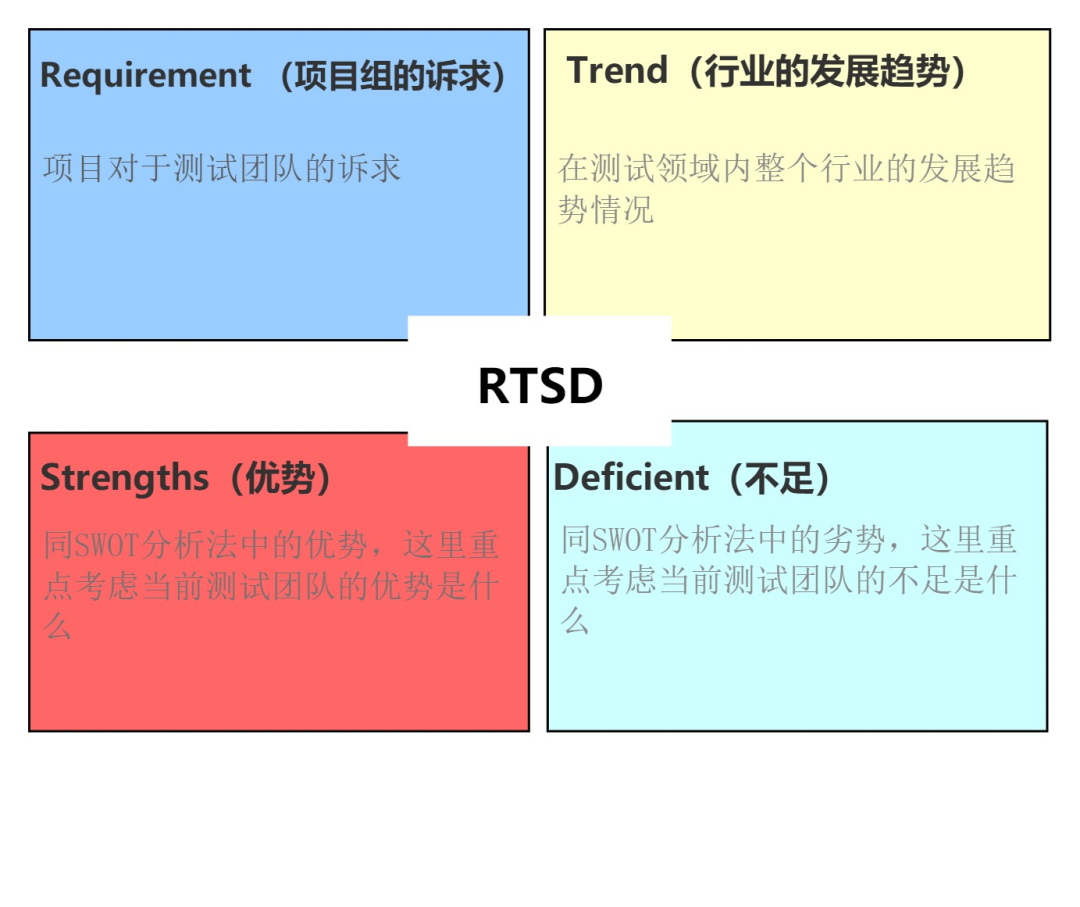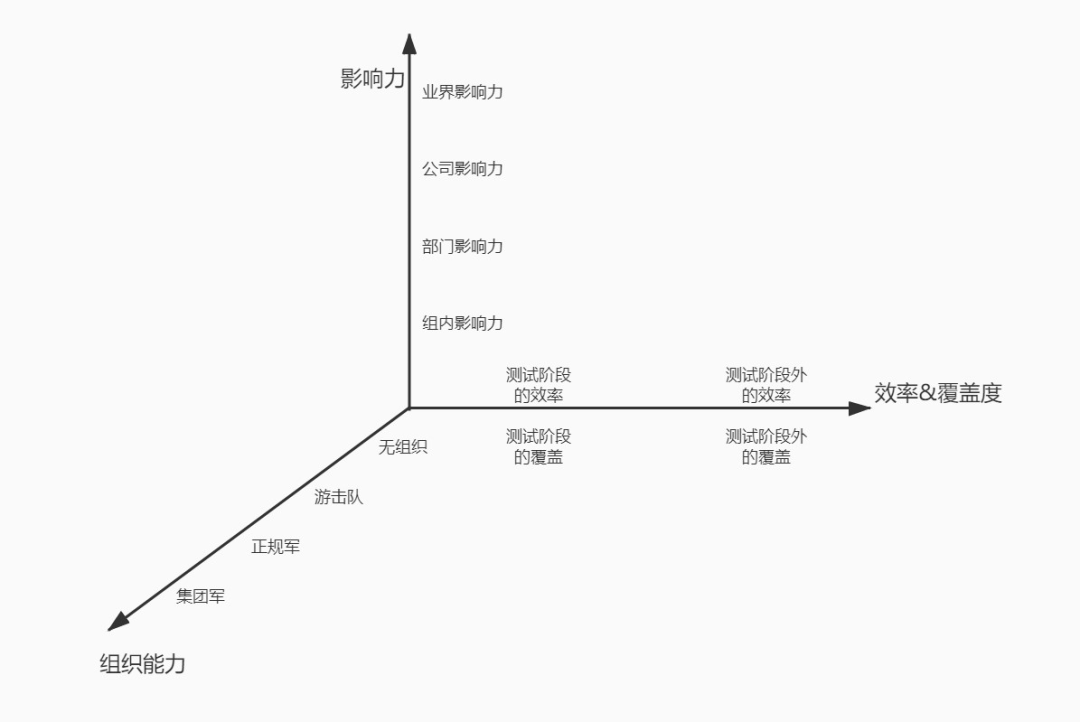Previous [Ten Years of Testing] Ten Years of Sogou Testing: Strategic Thinking (I) We introduced what is strategy and the importance of strategy. In this article, we will learn about common categories of strategy, strategic analysis methods and typical examples of competitive strategies. Finally, we will summarize the strategic analysis methods and common strategies of the test function in combination with the test function 。
Enterprise strategy division:
• Macro Strategy
• Competitive Strategy
• Functional Strategy
◆ Financial Strategy
◆ Customer Strategy
◆ Products Strategy
◆ Production Strategy
◆ R&D Strategy
◆ HR Strategy
◆ …..
Generally speaking, some typical cases we often see are the embodiment of competitive strategy. For example, the Internet strategy is to attract traffic through products, realize revenue through traffic, and further improve customer experience through revenue.
Note: The above content is quoted from the learning materials of Comprehensive Strategic Thinking on CEIBS Online.
Among the above types of strategies, the most common one is Competitive strategy ; In competitive strategy, the most common strategic analysis method is SWOT analysis method That is, analyze S (strengths), W (weaknesses), O (opportunities), and T (threats) to formulate corresponding strategies.
for instance
Assuming that we are a company focusing on shared travel, we will analyze whether to develop in the field of shared electric vehicles, and then apply SWOT analysis to get the following analysis:
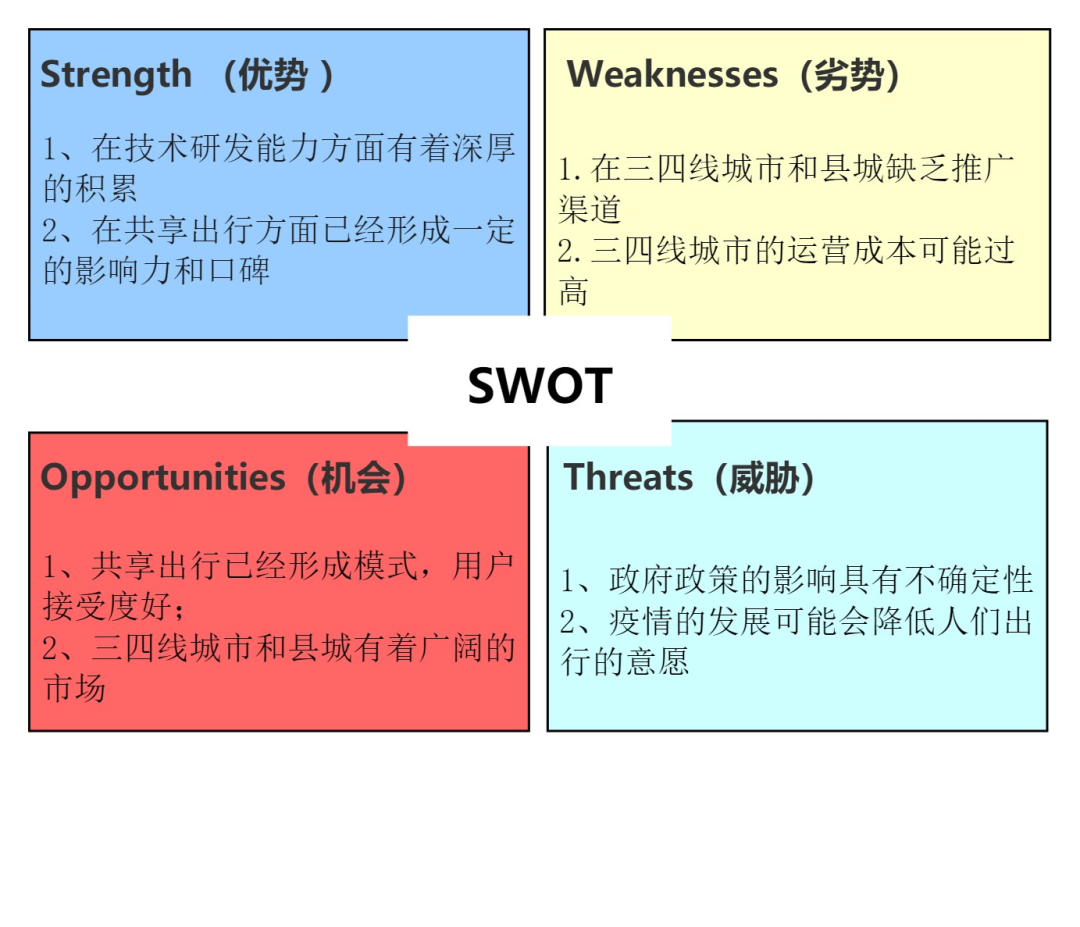
opportunity : Shared travel has formed a mode, which is well accepted by users; Third and fourth tier cities and counties have broad markets;
advantage : Have a deep accumulation in technology R&D capability; It has formed certain influence and reputation in sharing travel;
inferiority : Lack of promotion channels in third and fourth tier cities and counties; The operating costs of third and fourth tier cities may be too high;
threaten The impact of government policies is uncertain; The development of the epidemic may reduce people's willingness to travel.
In addition to the above most classic SWOT analysis method, there are also Boston matrix, five force model and other analysis methods. This article will not repeat, and interested students can query relevant information.
Through the above strategic analysis method, we essentially need to think about and answer the following core questions:
◆ Who are our customers? What is their value proposition?
◆ Who are our competitors? What are the advantages and disadvantages compared with them?
◆ What kind of strategy should we adopt?
In order to facilitate the above understanding, we understand its competitive strategy through a case.
Southwest Airlines
Company Profile Southwest Airlines, founded in 1971, was merged by four airlines. By 1993, it had become the 7th airline in the United States. It has 141 aircraft, with an annual turnover of 1.2 billion dollars and a net profit of nearly 75 million dollars.
Outstanding performance : The statistics of this company in 1993 are particularly impressive, because such companies as Delta, American and United suffered a lot of losses during this period. In the 22 years of operation of Southwest Airlines, except for the first two years, wave aside 。 When other airlines are struggling with bankruptcy, sacking drivers and mechanics, and closing certain routes, Southwest Airlines is vigorously promoting its growth plan and buying more aircraft, Open up new routes , Recruit new personnel 。
Competitive strategy : The difference between Southwest Airlines and other airlines is that they choose Focus on strategy : Provide customers with low-cost, frugal and specialized air transport services 。
concrete measure : Focusing on the above focused strategy, the specific measures carried out by Southwest Airlines include:
1. Although other major airlines are equipped with expensive computerized ticket booking systems, Southwest Airlines does not Not blindly imitate 。
2. On a Southwest Airlines plane, No first class seats , just like on a bus; The ticket checker shall issue tickets on a first come, first board basis Reusable Numbered plastic boarding card;
3. On the plane No meals This "no decoration" method makes passengers It takes a short time to get on and off the plane ——About 15 minutes, each plane flies 11 flights on average every day. When you see the working situation of ticket checkers, mechanics and ground crew of Southwest Airlines during the short interval of aircraft transfer, you will think of the precise operation team at the repair station in the middle of the race car. The result is The company's efficiency level and operating costs are absolutely ahead of its competitors 。
4. Southwest Airlines There is only one type of aircraft , that is, the fuel efficient Boeing 737 aircraft. Standardization of equipment Reduced parts inventory costs And minimize the breathing training of maintenance personnel.
5. Southwest Airlines basically No hub , are short haul, point-to-point flights, with an average flight time of 55 minutes. Because of this, it does not connect with other flights, nor does it need to transfer baggage.
6. Southwest Airlines has 34 cities in 15 states of the United States Concentrate on serving the sunshine zone and the central and western regions , as far east as Cleveland. However, although Southwest Airlines serves The number of cities is limited But it's in the middle of these cities Provide a large number of flights 。 For example, the company has 78 flights between Dallas and Houston every day; There are 46 flights between Phoenix and Los Angeles; There are 34 flights between Las Vegas and Phoenix. This makes it almost impossible for competitors to reach the service frequency of Southwest Airlines.
It is through the above focus strategy that the cost per effective seat per mile of Southwest Airlines is only 6.5 cents , and 9 cents for American Airlines , 15 cents for US Air Therefore, it has won several awards from the U.S. Department of Transportation“ three Heavy crown ”—— The best punctuality rate, the best flight safety record and the minimum number of complaints 。
Through the strategic analysis methods and cases introduced above, we can roughly Competitive strategy of enterprises With some understanding, let's talk about Strategic analysis method of test function And common strategies.
1) Strategic analysis method :
Referring to the general strategic analysis of the test team, we can conclude the following four aspects: Appeal of the project( requirement ) 、 Industry development trend 、 Strengths as well as Insufficient According to the naming method of SWOT, I name this method RTSD analysis method.
Project appeals : The project's appeal to the test team. As a supporting team, our functional strategy needs to consider the demands of the project on the test team.
For example, the project team has different demands for test teams in different stages and product periods, and early and fast iterative entrepreneurial products may not have high quality requirements, so the project team expects the test team to ensure the quality of key functions in a limited time. At this time, if the strategic planning of the test team is to establish a systematic and standardized process, It may be inappropriate to standardize the whole project.
Industry trends : The development trend of the whole industry in the field of testing. The test team's planning also needs to refer to the overall development trend of the industry.
For example, since 2015, the whole industry has witnessed the quality shift to the left represented by the continuous series, which has become the standard configuration of many companies. As the helmsman of the testing team, in the context of the times at that time, it is also necessary to refer to this development trend to formulate the corresponding strategic plan.
advantage : Same as the advantages in SWOT analysis, here we focus on what the advantages of the current test team are.
Insufficient : Same as the disadvantages in SWOT analysis method, here we focus on what are the shortcomings of the current test team.
2) Test Strategy Category
Through the general development law and past experience of the test team, the author summarized and formed Influence, organizational ability, efficiency coverage 3D of dimension Coordinate system, At the same time, combine the above RTSD analysis method to form the strategic development of the test team.
Generally speaking, according to different development periods, different project demands and different team characteristics, the test team has the following common strategic types: :
1、 "Form basic combat capability" This strategy is most common in the newly established test team. At this time, the test team manager should first establish the team (people), which can form a basic guarantee means (thing).
2、 "Improve testing efficiency and form organizational influence" This strategy is more common. When the test team develops to a certain extent, it will seek to improve the test efficiency and seek a certain influence within the group.
3、 "Improve coverage and form department influence" The most obvious aspect of this strategy is that it will no longer stick to the improvement and influence within the test team, but will radiate the influence to the department, such as the most common quality shift to the left and quality shift to the right. In addition to expanding the scope of quality assurance, it will also seek the influence of the organization in the department.
4、 "Group operation, benign competition" When the organization develops to a certain scale, the test team has developed from a guerrilla to a regular army. At this time, it is a common strategy to conduct benign competition within the organization and improve the ability and development of the entire test organization.
The above is the common test team development strategy summarized by the author based on past experience, hoping to help readers.
"Be ambitious, We hope that each of us will not only bow down to work, but also plan for the future.
Welcome to other series of articles in the testing decade:
[Ten years of testing] What skills should Sogou get in the first year of testing?
[Ten years of testing] The first year of Sogou testing: Careful
[ Ten years of testing ] The first year of Sogou test: integration into the team
[Ten years of testing] The first year of Sogou testing: active feedback
[Ten years of testing] The first year of Sogou testing: Not easy to draw conclusions
[Ten years of testing] The first year of Sogou testing: sense of responsibility
[Ten years of testing] The first year of Sogou testing: ensure correct communication information
[Test decade] What should Sogou get in the second year of the test?
[Test Decade] Sogou Test Year 2: Say "NO" to the workplace
[Test Decade] Sogou Test Year 2: Initiative Thinking
[Test decade] Sogou Test Year 2: Find the target and learn deeply
[Test Decade] Sogou Test Year 2: Alone
[Test Decade] Sogou Test Year 2: Regular Summary
[Test Decade] Sogou Test Year 2: Time Planning
[Ten years of testing] Sogou tests the skills to get in the third and fourth years
[Ten years of testing] The third and fourth years of Sogou testing: downward authorization
[Ten years of testing] The third and fourth years of Sogou testing: Basic chapter of bringing people
[Test Decade] Sogou Test Year Three or Four: Interview
[Test Decade] Sogou Test Year 3/4: Project Progress Control
[Ten years of testing] The third and fourth years of Sogou testing: project summary
[Ten years of testing] The third and fourth years of Sogou testing: guidance for newcomers
[Ten years of testing] Five or six years of Sogou testing: structured thinking (I)
[Ten years of testing] Five or six years of Sogou testing: Structured thinking (II)
[Ten years of testing] Five or six years of Sogou testing: Structured thinking (3)
[Ten years of testing] Five or six years of Sogou testing: Divergence thinking
[Ten years of testing] Five or six years of Sogou testing: reverse thinking
[ Ten years of testing] Five or six years of Sogou testing: Critical Thinking (I)
[Ten years of testing] Five or six years of Sogou testing: critical thinking (II)
[Ten years of testing] Seven or eight years of Sogou testing: methodological thinking
[Ten years of testing] Seven or eight years of Sogou testing: closed-loop thinking
[ Ten Years of Testing] Ten Years of Sogou Testing: Strategic Thinking (I)
[ Ten years of testing] How does Mentor define the problem of newcomers
[ Ten years of testing] How does Mentor discover the problems of new people
